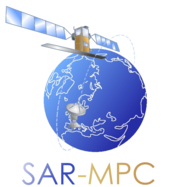
SAR-MPC News
In this section, we highlight main events related to products evolution, or new publications on product performances.
Update of IPF to version 003.92
Date 11 June 2025
This version introduces a correction of geodetic/geocentric computation that aims at improving the radiometric performances of the Level-1 products.
This correction will however only be activated for Sentinel-1C (neither for Sentinel-1A and Sentinel-1B historical products) to avoid breaking time series.
You can refer to SAR-MPC list of IPF version for the description of IPF changes.
Radiometric calibration and geometric calibration of Sentinel-1C WV products
Date 21 May 2025
Since 2025-05-21 afternoon, the processing configuration of Sentinel-1C was updated to implement adjustements of the processing gains for WV1 and WV2 beams.
The WV products acquired after this update are calibrated and operationaly qualified.
However, an update of the calibration of their denoising vectors still needs to be performed in the coming weeks.
Fine tuning of the calibration for all modes will occur in the coming months by circulating additional configuration files and deploying a new IPF version. Moreover, it is noted that product quality monitoring and tunning of calibration is continuously done during the mission lifetime to ensure the product performance is maintained.
The quality disclaimer QD-269 will be updated to reflect this update and provide more details.
Radiometric and geometric calibration of Sentinel-1C EW/IW/SM products
Date 19 May 2025
Since the 2025-05-19 afternoon, the processing configuration of Sentinel-1C was updated to implement the recommendations of the In-Orbit Commissioning (IOC) activities. This includes updates of:
- sampling window start time and azimuth time bias
- update of the elevation and azimuth antenna patterns
- update of calibration constant for all modes
- update of noise calibration factor for EW and IW modes
The EW, IW and Stripmap products acquired after this update are calibrated and operationaly qualified
The WV products require further adjustements to be implemented in the coming days, including update of their denoising vectors.
Fine tuning of the calibration for all modes will occur in the coming months by circulating additional configuration files and deploying a new IPF version. Moreover, it is noted that product quality monitoring and tunning of calibration is continuously done during the mission lifetime to ensure the product performance is maintained.
The quality disclaimer on status of the products during the ICO (QD-269) will be updated to reflect this update and provide more details.
The configuration of the SETAP processor was updated to reflect those changes. Content of the ETAD products are aligned with the current status of Sentinel-1C Level 1 production expect for 27 products in a transition period on 2025-05-19. A specific Quality Disclaimer (QD-276) is under preparation.
Activation of RFI mitigation strategy for Sentinel-1C
Date 15 May 2025
Since the 2025-05-15 afternoon, the Radio Frenquency Interference (RFI) mitigation strategy was activated for Sentinel-1C production, just like for Sentinel-1A.
Please note that Sentinel-1C products are still not yet fully calibrated and qualified and that the quality disclaimer QD-269 still applies for the moment.
Updates are planned in the coming days to ensure a initial calibration of the Sentinel-1C products, that will be then further refined in the coming months and during the mission lifetime.
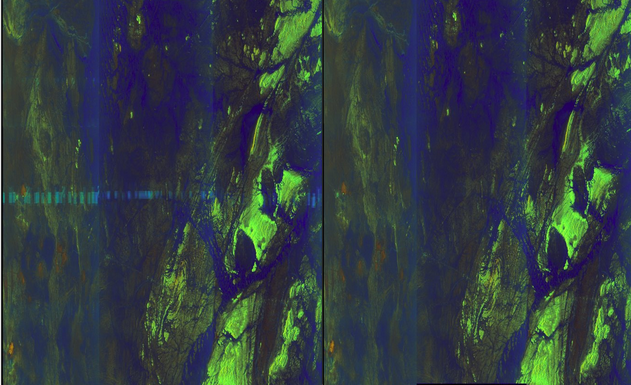
(left) original S1C product without RFI mitigation, (right) S1C product reprocessed with RFI mitigation activated and representative of the production since 2025-05-15 afternoon.
Note that despite the activation of this RFI mitigation, some RFI residual are expected.
The percentage of products impacted by RFI residual is reported monthly in quality disclaimers available here Quality Disclaimers web page
Update of S1C AUX_ITC
Date: 12 May 2025
The S1C AUX_ITC was updated to document the range and azimuth bias characterized during the In Orbit Commissioning Review.
This configuration is temporary, waiting for direct compensation of the range and azimuth bias as part of Level-1 processing. Once applied, the bias documented in AUX_ITC (and hence in SETAP products) will be reverted to 0.
Annual performance report for year 2024
Date: March 2025
The Sentinel-1 Annual Performance Report for 2024 in availabl on Sentiwiki in [Annual Report] section
Sentinel-1C first images
The SAR Mission Performance Cluster Service (SAR-MPC) join in celebrating the succesful launch of Sentinel-1C and the following acquisition of its first images only few days after.
ESA official communication on first Sentinel-1C images
Endorsement of Sentinel-1 IPF Auxiliary Data Files
Date: 2024-12-04
The SAR-MPC is responsible of the production of the the Sentinel-1 IPF (Processor) Auxiliary Data Files, including AUX_INS, AUX_CAL, AUX_PP1, AUX_PP2, AUX_ML2, AUX_SCS and AUX_ITC.
Specific processing parameters and hence specific Auxiliary Data Files (ADFs) are generated for Sentinel-1A, Sentinel-1B and Sentinel-1C.
We endorsed today the first operational version of those ADF for Sentinel-1C and we are looking forward to its launch today 2024-12-04 at 22:20 CET.
Hurricane monitoring with SAR imagery
Date: 2024-10-16
The SAR-MPC is providing support to ESA for a specific tasking of Sentinel-1 image acquisitions over Hurricanes.
This task is a follow on of the CYMS project, now part of the SAR-MPC activities.
Those specific acquisitions are then used to build databases of observations of hurricanes aiming at improving the measurement of geophysical parameters over such events.
This complements similar acquisitions performed by other space agencies for the understanding of those extreme events.
More information and data available on the CYMS website and on the Ifremer Cyclops database
Below is example of hurricane Helene with wind measurement performed as part of this initiative.
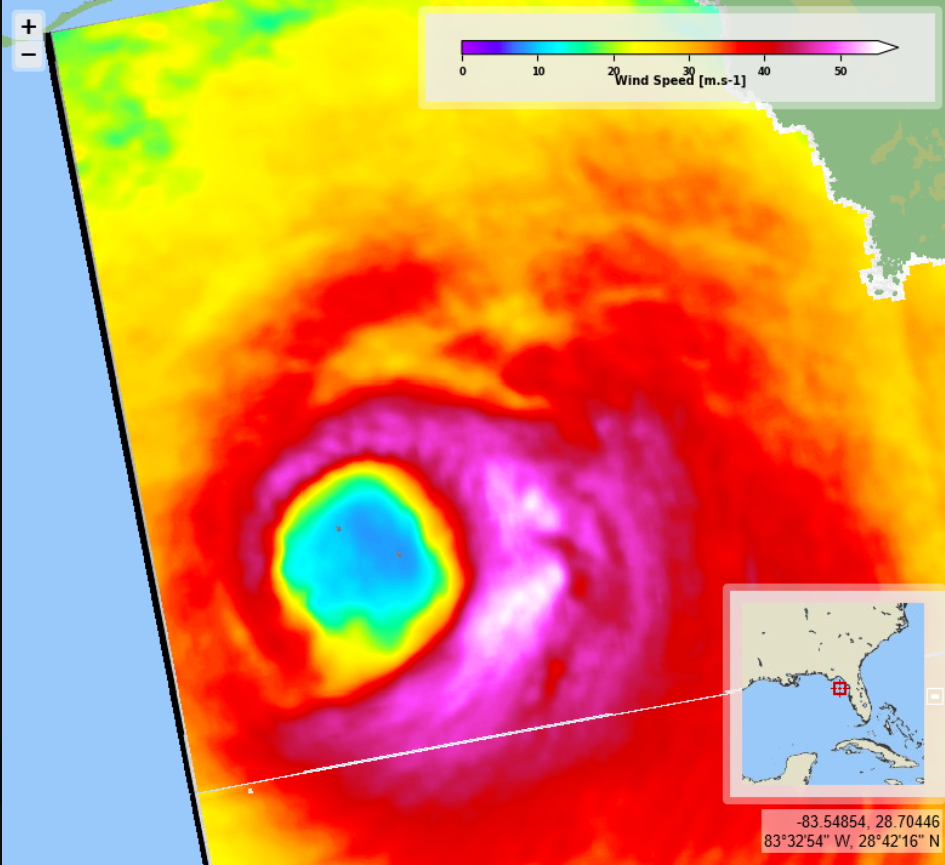
Publication of the fifth Sentinel-1A N-Cyclic Performance Report for 2024
Date: 2024-10-03
We published the fifth N-Cyclic Sentinel-1A performance report for 2024. It is available [Here] together with the previous one of the year.
It contains the main events that may affect the Sentinel-1 product performances and the main results of monitoring for the cyles 329 to 332.
(Please note that the news about publication of previous N-Cyclic reports are removed from this site when new reports are published)
Publication of the Sentinel-1 Annual Performance Report 2023
Date: 2023-04-22
The annual performance report for the Sentinel-1 mission for 2023 is available [Here].
It contains the full status of Sentinel-1 product performances (Level 1, Level 2, ETAD products) and the full list of quality disclaimers currently published (available as well on this site).
Compared to previous yearly reports it contains results of long-term monitoring of the mission, as for instance below for interferometric baseline component from 2015 ("current" cycle vs previous one).
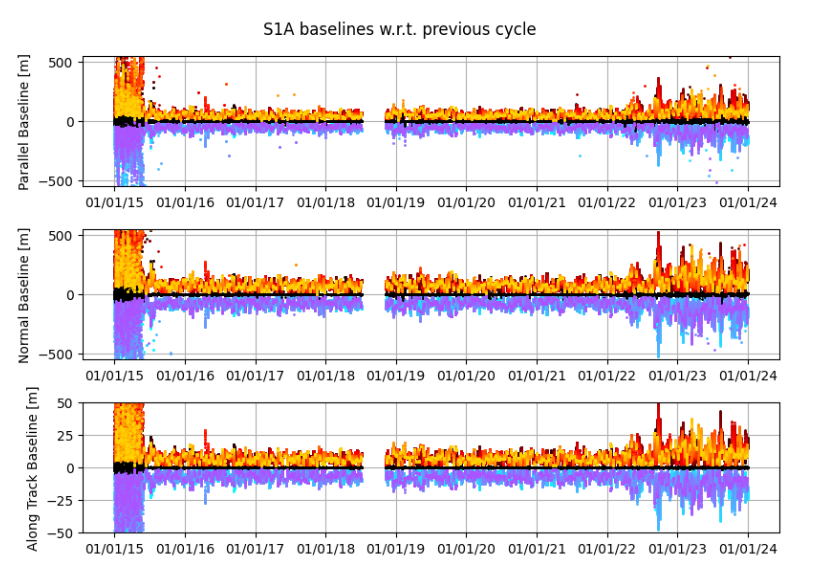
Publication of the Sentinel-1A N-Cyclic Report (last report of 2023)
Date: 2023-03-22
A new edition of the Sentinel-1A mission N-Cyclic Performance Report is available [Here] (8th N-Cyclic Performance Report of 2023)
Performance Reports are provided for periods of four cycles (48 days) to report the status of the mission to the end-users. This document provides a status on the S1-A sensor and product performance for orbit repeat cycle 297 to 300.
Please notice that the N-Cyclic Performances Reports are regularly unpublished once the Annual Performance Report covering the same period are available. The Annual Performance Report contains much more information.
How to improve temporal consistence in S1 radiometric time series ?
Date: 2024-02-02
A while ago, Kersten Schmidt, et al from the SAR-MPC, has published a paper on how to improve temporal consistence in S1 radiometric time series using an easy post-processing approach.
We use this method for long term monitoring of Sentinel-1 products performances taking into account successive improvment of radiometric calibration.
The paper is available here Radiometric Re-Compensation of Sentinel-1 SAR Data Products for Artificial Biases due to Antenna Pattern Changes
The method is using the archives of auxiliary data files (ADF) available on the SAR-MPC website. A Rest API allows accessing them easily (the documentation of the interface is here).
We now continue the work aiming to provide consistent and improved noise vectors for the thermal de-noising of fresh and archive S1 data.
Availability of ETAD products
Date: 2024-01-16
Publication of the Sentinel-1 mission N-Cyclic Report
Date: 2023-09-20
A new edition of the Sentinel-1 mission N-Cyclic Performance Report is available [Here] (fifth N-Cyclic Performance Report of 2023)
Performance Reports are provided every four cycles (48 days) to report the status of the mission to the end-users. This document provides a status on the S1-A sensor and product performance for orbit repeat cycle 297 to 300.
Please notice that the N-Cyclic Performances Reports are regularly unpublished once the Annual Performance Report covering the same period are available. The Annual Performance Report contains much more information.
Solar activity
Date : 2023-08-03
We are in a period of increase of solar activity. This increases the numbers of geomagnetic storms that make it more difficult to predict and restitute the orbits of the Sentinel-1 mission. During such events some predicted (AUX_PREORB) and restituted (AUX_RESORB) may have an accuracy worse than their performance requirements.
A Quality Disclaimer presenting the list degraded AUX_PREORB, AUX_RESORB and of Sentinel-1 Level-1 products generated with those orbit files is available https://sar-mpc.eu/disclaimer/159/ for the period January to July 2023.
Future quality disclaimer on this topic will be published monthly.
The precise orbit ephemerid orbits (AUX_POEORB) are not impacted.
Publication of the Sentinel-1 mission N-Cyclic Report
Date : 2023-01-19
A new edition of the Sentinel-1 mission N-Cyclic Performance Report is available [Here]
Performance Reports are provided every four cycles (48 days) to report the status of the mission to the end-users. This document provides a status on the S1-A sensor and product performance for orbit repeat cycle 277 to 280.
Please notice that the N-Cyclic Performances Reports are regularly unpublished once the Annual Performance Report covering the same period are available. The Annual Performance Report contains much more information. Next edition for 2022 will be available in the coming weeks.
New version of Sentinel-1 product specification
Date: 2022-10-11
A new version of the Sentinel-1 product specification (version 3.12) is now available Here
This version of the product specification will be used by the SAR processor IPF 3.60 to be deployed in the coming months.
This version of the processor is introducing the following main changes:
- general improvment of robustness of the processing (Level 1 and Level 2)
- ensure complete coverage in range of the denoising vectors for GRD products
- annotation of the complete set of Level 0 products used as input of the processing
- adding some additional global variables in the Level 2 NetCDF content
- using a new coastline in the Level 2 processing (OpenStreetMap instead of GSHHS)
- introducing quicklooks of Level2 Wind and Radial Velocity Measurements for TOPS and Stripmap products
Sample products will be made available in the coming weeks.
CEOS SAR WGCV 2022
The results from the SAR MPC will be presented in the CEOS Working Group on Calibration and Validation (WGCV), SAR Subgroup Workshop 2022 (CEOS SAR WGCV 2022)
This workshop takes place on October 18-21, 2022 Montreal, Canada
Two presentations of SAR-MPC results will be exposed on radiometric performances and rfi mitigation.
Total significant wave height is now provided for the Sentinel-1 Wave Mode acquisitions
Date: 2022-06-29
Since the beginning of operations of the Sentinel-1 mission, Wave Mode OCN products contain the significant wave height of the swell for each wave partition observed by the SAR instrument.
Since 2022-06-07, the Wave Mode OCN products contain as well the "Total" significant wave height (not only from the swell component) as extracted using the Neural Network algorithm described in [Quach et al 2020] and trained on altimeter measurements.
Two new variables are provided: oswTotalHs (significant wave height) and oswTotalHsStdev (standard deviation of significant wave height). These variables are qualified as "total" to avoid any confusion with the oswHs variable that is already used for the significant wave height of the swell for each wave partition in the products.
The first operational validation of this new measurement illustrates good match with reference mean Hs from CMEMS, as can be seen by the scatter plot and metrics provided in the figure below.
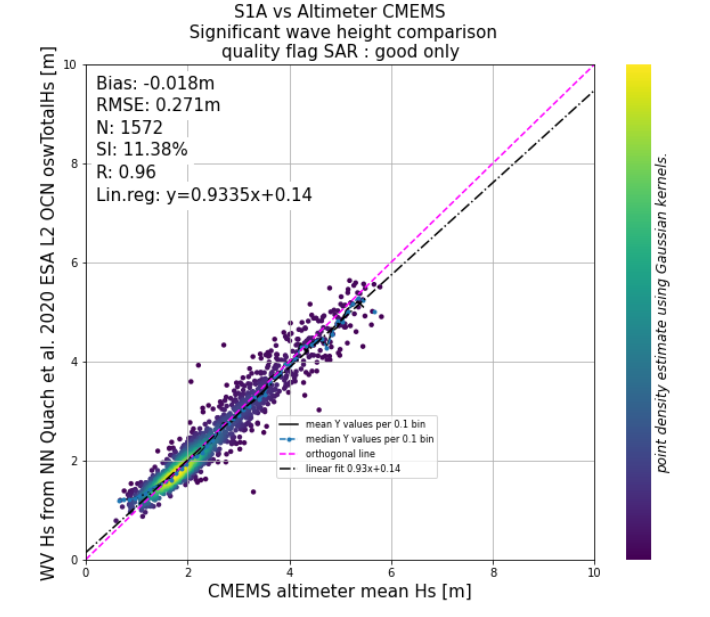
[Quach et al 2020] Quach, B., Glaser, Y., Stopa, J. E., Mouche, A. A., & Sadowski, P. (2020). Deep learning for predicting significant wave height from synthetic aperture radar. IEEE Transactions on Geoscience and Remote Sensing, 59(3), 1859-1867.
Sentinel-1 mission performance and product evolution in Living Planet 2022
Date: 2022-03-21
The status of the Sentinel-1 mission and the product evolutions will be presented during a dedicated session of the Living Planet 2022 symposium.
The Sentinel-1 product users will be able to meet representatives of the SAR Mission Performance Cluster during the
Update of IPF
Date: 2022-03-15
An evolution of the Sentinel-1 processing baseline will be introduced on 23 March for all newly generated products. This evolution features two main items:
- A minor evolution of the Sentinel-1 Level-2 OCN product format, in line with the product format version 3.11. The subject product format specifications are available here together with a set of corresponding sample products.
- Further to our news of 03 September 2021 the correction of Radio Frequency Interference (RFI) will be applied to IW and EW products.
This evolution will be activated with the deployment of the new instrument processor version 3.5.1.
Products generated after the deployment of this version will tag version 3.5.1 of the operational processor in the corresponding product metadata and will be aligned with the new product format specifications 3.11.
Publication of Annual Performance Report 2021
Date: 2022-03-04
The annual performance report for the Sentinel-1 mission was published on 2022-03-04